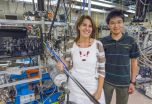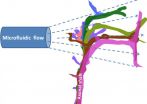(Press-News.org) Imagine being able to take a pill that lets you eat all of the ice cream, cookies, and cakes that you wanted – without gaining any weight.
New research from USC suggests that dream may not be impossible. A team of scientists led by Sean Curran of the USC Davis School of Gerontology and the Keck School of Medicine of USC found a new way to suppress the obesity that accompanies a high-sugar diet, pinning it down to a key gene that pharmaceutical companies have already developed drugs to target.
So far, Curran's work has been solely on the worm Caenorhabditis elegans and human cells in a petri dish – but the genetic pathway he studied is found in almost all animals from yeast to humans. Next, he plans to test his findings in mice.
Curran's research is outlined in a study that will be published on Oct. 6 by Nature Communications.
Building on previous work with C. elegans, Curran and his colleagues found that certain genetic mutants – those with a hyperactive SKN-1 gene – could be fed incredibly high-sugar diets without gaining any weight, while regular C. elegans ballooned on the same diet.
"The high-sugar diet that the bacteria ate was the equivalent of a human eating the Western diet," Curran said, referring to the diet favored by the Western world, characterized by high-fat and high-sugar foods, like burgers, fries and soda.
The SKN-1 gene also exists in humans, where it is called Nrf2, suggesting that the findings might translate, he said. The Nrf2 protein, a "transcription factor" that binds to a specific sequence of DNA to control the ability of cells to detox or repair damage when exposed to chemically reactive oxygen (a common threat to cells' well being), has been well studied in mammals.
Pharmaceutical companies have already worked to develop small-molecule drugs that target Nrf2, in hopes that it will produce more anti-oxidants and slow aging.
Though the promise of a pill to help control your body's response to food is enticing, it is not without risk, Curran said. Increased Nrf2 function has been linked to aggressive cancers.
"Perhaps it is a matter of timing and location," Curran said. "If we can acutely activate Nrf2 in specific tissues when needed then maybe we can take advantage of its potential benefits."
INFORMATION:
Curran, the corresponding author on the study, collaborated with Shanshan Pang and Jennifer Paek of USC Davis; and Dana Lynn and Jacqueline Lo of USC Davis and the USC Dornsife College of Letters, Arts and Sciences.
This research was funded by the National Institutes of Health (P40 OD010440 and AG032308), the Ellison Medical Foundation, and the American Federation of Aging Research.
High-sugar diet no problem for genetic mutants
Working with worms, scientists find a link between a genetic mutation and how diets are processed
2014-10-06
ELSE PRESS RELEASES FROM THIS DATE:
Does emotional stability affect the success of online poker players?
2014-10-06
New Rochelle, NY, October 6, 2014—While poker is a game of chance, there is skill and decision-making involved, and the quality of those decisions depends on both knowledge of the game and the ability to control one's emotions. The results of a new study that evaluates emotionality, experience level, and success among online poker players are presented in Cyberpsychology, Behavior, and Social Networking, a peer-reviewed journal from Mary Ann Liebert, Inc., publishers. The article is available free on the Cyberpsychology, Behavior, and Social Networking website until ...
Study: 'Broad consensus' that violent media increase child aggression
2014-10-06
COLUMBUS, Ohio – Majorities of media researchers, parents and pediatricians agree that exposure to violent media can increase aggression in children, according to a new national study.
The study found that 66 percent of researchers, 67 percent of parents and 90 percent of pediatricians agree or strongly agree that violent video games can increase aggressive behavior among children.
Majorities of these groups also believed that children's aggressive behavior can be fueled by viewing violent video games, movies, TV programs, and Internet sites. However, fewer than ...
A quick look at electron-boson coupling
2014-10-06
Imagine being able to tune the properties of a solid material just by flashing pulses of light on it, for example turning an insulator into a superconductor. That is just one potential payoff down-the-road from the physical phenomenon of electrons and atoms interacting with ultrashort pulses of light. The technology of ultrafast spectroscopy is a key to understanding this phenomenon and now a new wrinkle to that technology has been introduced by Berkeley Lab researchers.
In a study led by Alessandra Lanzara of Berkeley Lab's Materials Sciences Division, time- and angle-resolved ...
How rabies 'hijacks' neurons to attack the brain
2014-10-06
Rabies causes acute inflammation of the brain, producing psychosis and violent aggression. The virus, which paralyzes the body's internal organs, is always deadly for those unable to obtain vaccines in time. Some 55,000 people die from rabies every year.
For the first time, Tel Aviv University scientists have discovered the exact mechanism this killer virus uses to efficiently enter the central nervous system, where it erupts in a toxic explosion of symptoms. The study, published in PLOS Pathogens, was conducted by Dr. Eran Perlson and Shani Gluska of TAU's Sackler Faculty ...
Penn Medicine study finds tongue fat and size may predict sleep apnea in obese adults
2014-10-06
Obesity is a risk factor for many health problems, but a new Penn Medicine study published this month in the journal Sleep suggests having a larger tongue with increased levels of fat may be a sign of obstructive sleep apnea (OSA) in obese adults.
The researchers examined tongue fat in 31 obese adults who had OSA and 90 obese adults without the condition. All subjects underwent magnetic resonance imaging and the size and distribution of upper airway fat deposits in their tongue and upper airway muscles measured.
"Previous studies showed that the human tongue has a high ...
UT Arlington researchers demonstrate direct fluid flow influences neuron growth
2014-10-06
A University of Texas at Arlington team exploring how neuron growth can be controlled in the lab and, possibly, in the human body has published a new paper in Nature Scientific Reports on how fluid flow could play a significant role.
In a new study co-authored by Samarendra Mohanty, leader of the Biophysics and Physiology Lab in the College of Science, the researchers were able to use microfluidic stimulations to change the path of an axon at an angle of up to 90 degrees. Axons are the shafts of neurons, on the tips of which connections are made with other neurons or cells. ...
Are leaders born or made? New study shows how leadership develops
2014-10-06
URBANA, Ill. – Hardly a day passes without pundits crying for leadership in the NFL commissioner and team owners, among high-ranking government officials, and in other public figures. If University of Illinois experts didn't have evidence that this valuable trait can be taught, they might join the collective swoon that's engulfing much of the country.
But a new U of I study supports the idea that leaders are made, not born, and that leadership development follows a specific progression.
Past research suggests that leadership is 30 percent genetic and 70 percent a result ...
Natural gene selection can produce orange corn rich in provitamin A for Africa, US
2014-10-06
WEST LAFAYETTE, Ind. - Purdue researchers have identified a set of genes that can be used to naturally boost the provitamin A content of corn kernels, a finding that could help combat vitamin A deficiency in developing countries and macular degeneration in the elderly.
Professor of agronomy Torbert Rocheford and fellow researchers found gene variations that can be selected to change nutritionally poor white corn into biofortified orange corn with high levels of provitamin A carotenoids - substances that the human body can convert into vitamin A. Vitamin A plays key roles ...
Montefiore & Einstein investigators present research at 2014 AAP National Conference & Exhibition
2014-10-06
NEW YORK (October 6, 2014) – Investigators at The Children's Hospital at Montefiore (CHAM) and Albert Einstein College of Medicine of Yeshiva University will present their latest research on neonatal lung disease, reducing wrong-patient errors in the NICU, hormonal contraception and more at the AAP Experience, the National Conference & Exhibition of the American Academy of Pediatrics. The AAP Experience will take place October 11-14 in San Diego, California.
Judy Aschner, M.D., F.A.A.P., physician-in-chief, CHAM, professor of pediatrics and Michael I. Cohen, M.D., University ...
Less than half of Canadians exercise to relieve stress
2014-10-06
Hamilton, ON (October 6, 2014) – A research study out of McMaster University has found that only 40 per cent of Canadians exercise to cope with stress.
The researchers analyzed data from Statistics Canada's Canadian Community Health Survey of nearly 40,000 Canadians 15 and older. Of 13 coping behaviours or strategies polled, exercise was ranked eighth, meaning people were more likely to cope with stress by problem-solving; looking on the bright side, trying to relax, talking to others, blaming oneself, ignoring stress or praying, rather than being active.
"We know ...
LAST 30 PRESS RELEASES:
Eye for trouble: Automated counting for chromosome issues under the microscope
The vast majority of US rivers lack any protections from human activities, new research finds
Ultrasound-responsive in situ antigen "nanocatchers" open a new paradigm for personalized tumor immunotherapy
Environmental “superbugs” in our rivers and soils: new one health review warns of growing antimicrobial resistance crisis
Triple threat in greenhouse farming: how heavy metals, microplastics, and antibiotic resistance genes unite to challenge sustainable food production
Earthworms turn manure into a powerful tool against antibiotic resistance
AI turns water into an early warning network for hidden biological pollutants
Hidden hotspots on “green” plastics: biodegradable and conventional plastics shape very different antibiotic resistance risks in river microbiomes
Engineered biochar enzyme system clears toxic phenolic acids and restores pepper seed germination in continuous cropping soils
Retail therapy fail? Online shopping linked to stress, says study
How well-meaning allies can increase stress for marginalized people
Commercially viable biomanufacturing: designer yeast turns sugar into lucrative chemical 3-HP
Control valve discovered in gut’s plumbing system
George Mason University leads phase 2 clinical trial for pill to help maintain weight loss after GLP-1s
Hop to it: research from Shedd Aquarium tracks conch movement to set new conservation guidance
Weight loss drugs and bariatric surgery improve the body’s fat ‘balance:’ study
The Age of Fishes began with mass death
TB harnesses part of immune defense system to cause infection
Important new source of oxidation in the atmosphere found
A tug-of-war explains a decades-old question about how bacteria swim
Strengthened immune defense against cancer
Engineering the development of the pancreas
The Journal of Nuclear Medicine ahead-of-print tip sheet: Jan. 9, 2026
Mount Sinai researchers help create largest immune cell atlas of bone marrow in multiple myeloma patients
Why it is so hard to get started on an unpleasant task: Scientists identify a “motivation brake”
Body composition changes after bariatric surgery or treatment with GLP-1 receptor agonists
Targeted regulation of abortion providers laws and pregnancies conceived through fertility treatment
Press registration is now open for the 2026 ACMG Annual Clinical Genetics Meeting
Understanding sex-based differences and the role of bone morphogenetic protein signaling in Alzheimer’s disease
Breakthrough in thin-film electrolytes pushes solid oxide fuel cells forward
[Press-News.org] High-sugar diet no problem for genetic mutantsWorking with worms, scientists find a link between a genetic mutation and how diets are processed



